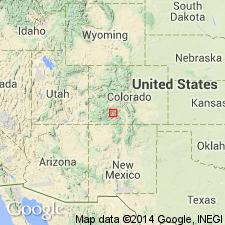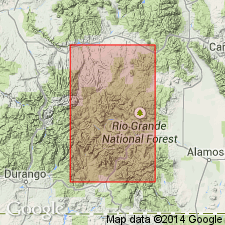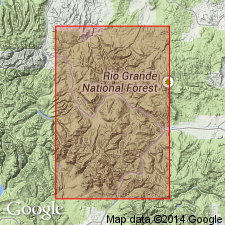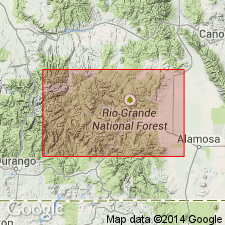
- Usage in publication:
-
- Bachelor Mountain Rhyolite*
- Modifications:
-
- Original reference
- Dominant lithology:
-
- Rhyolite
- AAPG geologic province:
-
- San Juan Mountains province
Summary:
Pg. D54-D63. Bachelor Mountain Rhyolite. Formal proposal. Name given to all rhyolitic rocks included by Emmons and Larsen (1923) in their Willow Creek Rhyolite, Campbell Mountain Rhyolite, Windy Gulch Rhyolite Breccia, and intrusive rhyolite porphyry. Emmons and Larsen described Willow Creek and Campbell Mountain Rhyolites as two sequences of lava flows and flow breccias separated by irregular erosion surface, and they included both in their Alboroto Group. They believed that Windy Gulch Rhyolite Breccia was separated from Campbell Mountain Rhyolite by major unconformity, and placed it in their Piedra Group. Present study shows that Willow Creek, Campbell Mountain, and Windy Gulch are members (all reduced in rank) of intragradational sequence of pumiceous pyroclastic rocks that warrants formational rank. Bachelor Mountain consists of phenocrysts (5 percent or less) and foreign rock fragments (20 percent or less) in a microcrystalline to cryptocrystalline matrix. Includes (in ascending order) Willow Creek Member, 2,000+ feet; Campbell Mountain Member, 1,000+ feet; and Windy Gulch Member, 900+ feet. Breaks in the sequence occur only where Bachelor Mountain rocks intertongue with other volcanic rocks at margins of the deposit. No single complete section of formation exposed in central San Juan Mountains. Campbell Mountain and Windy Gulch Members intertongue laterally with flows and breccias of Shallow Creek Quartz Latite (new) to west, and lens of typical Campbell Mountain is interlayered with Phoenix Park Member of La Garita Quartz Latite (new) to east. Eruption of Bachelor Mountain Rhyolite culminated in collapse of Bachelor Mountain cauldron near Creede, and in development of series of normal faults that extend north to northwest out from more strongly subsided area. Age is middle or late Tertiary. [The USGS currently (ca. 1965) designates the age of the Bachelor Mountain Rhyolite as Oligocene on the basis of a study now in progress. See entry under Steven and others (1967).] Considered older than Farmers Creek Rhyolite and the Huerto Formation.
Type area: on Bachelor Mountain, northwest of Creede, Mineral Co., CO; exposures are discontinuous.
Source: US geologic names lexicon (USGS Bull. 1350, p. 39-40); supplemental information from GNU records (USGS DDS-6; Denver GNULEX).

- Usage in publication:
-
- Bachelor Mountain Rhyolite*
- Modifications:
-
- Age modified
- AAPG geologic province:
-
- San Juan Mountains province
Summary:
Bachelor Mountain Rhyolite. Age changed from middle or late Tertiary --to-- Oligocene. (Adopted by the USGS.) [On p. D49 (table 1) shown older than informal tuff of Fish Canyon (27.2 +/-0.7 Ma) and younger than La Garita Quartz Latite (27.8 +/-1.3 Ma). Includes (descending) Windy Gulch, Campbell Mountain, and Willow Creek Members.]
Source: Publication; Changes in stratigraphic nomenclature, 1968 (USGS Bull. 1294-A, p. A2).

- Usage in publication:
-
- Bachelor Mountain Member*
- Modifications:
-
- Revised
- AAPG geologic province:
-
- San Juan Mountains province
Summary:
Pg. A4-A5, A78-A79. Bachelor Mountain Member of Carpenter Ridge Tuff. Bachelor Mountain Rhyolite is reduced in stratigraphic rank to upper member (of 2) of Carpenter Ridge Tuff. Includes (in ascending order) Willow Creek Bed, Campbell Mountain Bed, and Windy Gulch Bed (all reduced in rank). Some rocks formerly assigned to Piedra Rhyolite† (abandoned) are included in the Bachelor Mountain. Overlies unnamed outflow member of Carpenter Ridge. Age is late Oligocene.
Source: Publication; supplemental information from GNU records (USGS DDS-6; Denver GNULEX).

- Usage in publication:
-
- Bachelor Mountain Member*
- Modifications:
-
- Revised
- AAPG geologic province:
-
- San Juan Mountains province
Summary:
Bachelor Mountain Member of Carpenter Ridge Tuff revised. Willow Creek, Campbell Mountain, and Windy Gulch Beds are relegated to informal status and are referred to as zones within the Bachelor Mountain. Units were once thought to constitute discrete eruptive deposits but recent work in Creede area, Mineral County, Colorado, has shown that within central part of Bachelor caldera in San Juan volcanic field, units represent upward sequence of progressively less welded zones within thick rhyolitic caldera fill. Is younger than Fish Canyon Tuff; underlies Mammoth Mountain unit in Carpenter Ridge Tuff. Age is Oligocene (27.35 Ma).
Source: Modified from GNU records (USGS DDS-6; Denver GNULEX).
For more information, please contact Nancy Stamm, Geologic Names Committee Secretary.
Asterisk (*) indicates published by U.S. Geological Survey authors.
"No current usage" (†) implies that a name has been abandoned or has fallen into disuse. Former usage and, if known, replacement name given in parentheses ( ).
Slash (/) indicates name conflicts with nomenclatural guidelines (CSN, 1933; ACSN, 1961, 1970; NACSN, 1983, 2005, 2021). May be explained within brackets ([ ]).

